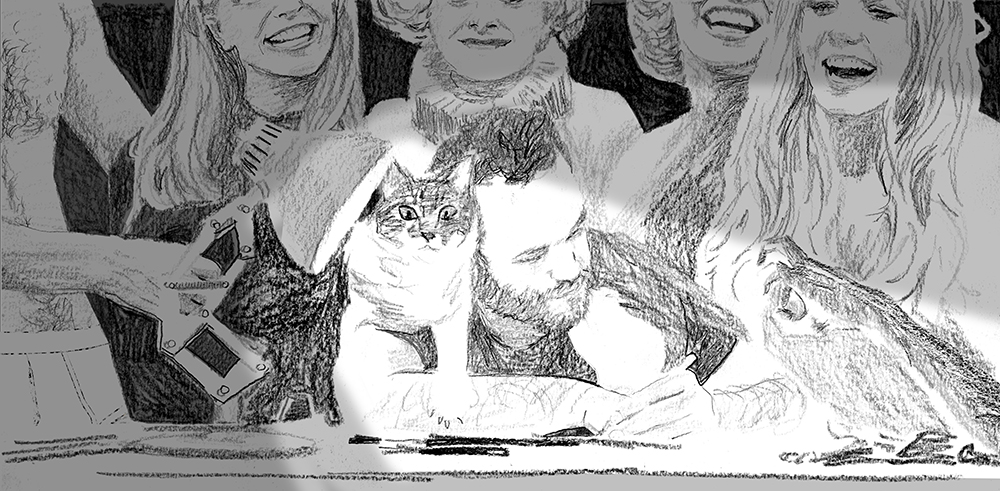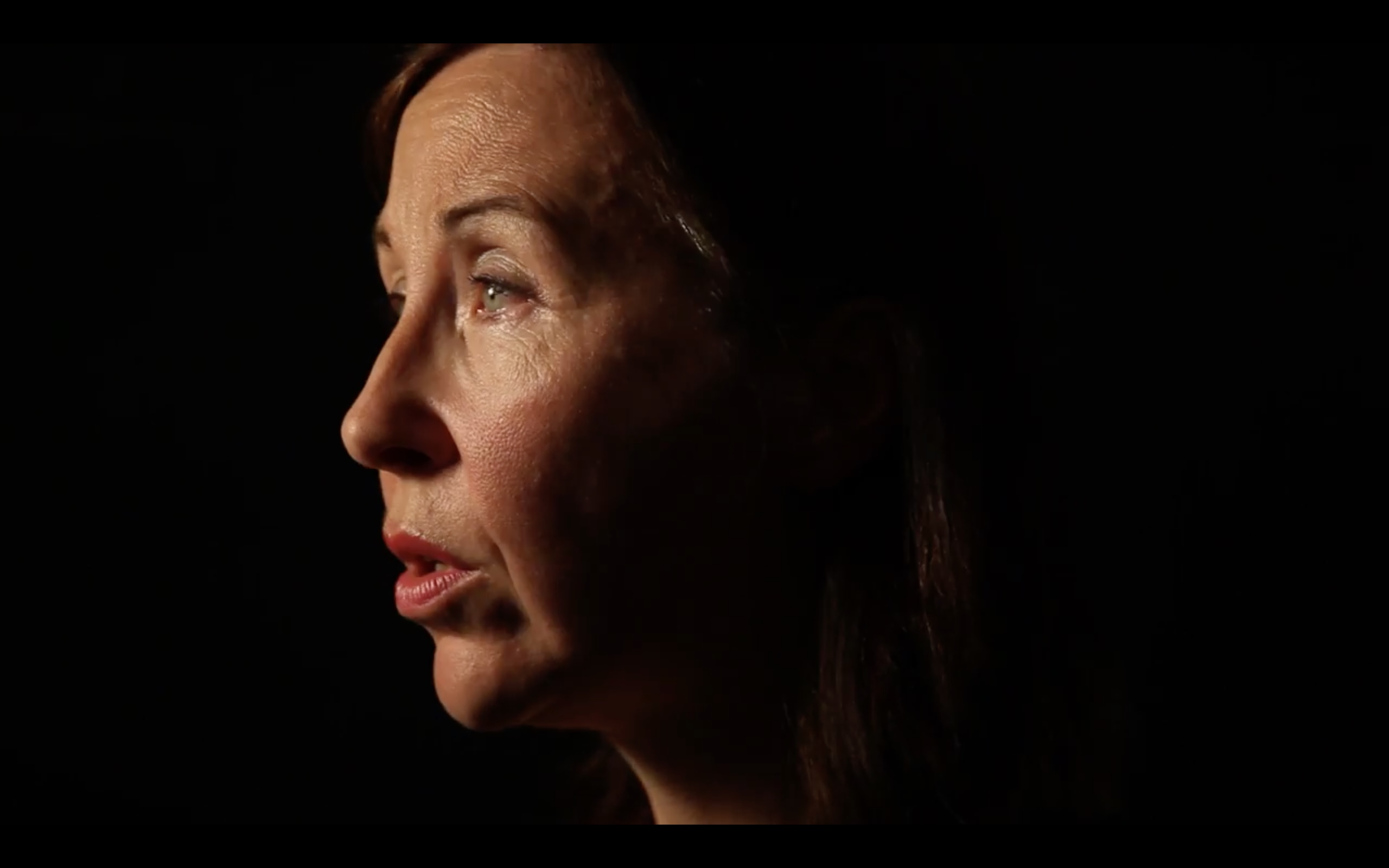Maxime Parodi
Revenge of the night
Exhibition Past
April 12 to May 31, 2025
Opening Friday, April 11, 6pm
Closing May 31, 8pm
Galerie Eva Vautier is delighted to present, for the first time, a solo exhibition by artist Maxime Parodi. After taking part in several group shows in Nice, notably at Villa Cameline and 109, Maxime Parodi now takes over the gallery with a series of new works exploring the theme of the home.
A 2012 graduate of the École supérieure d'art d'Aix-en-Provence, Maxime Parodi defines himself as a “fictionaute”: an explorer of fictional worlds. Through drawing and writing, he integrates himself into scenes from films to which he is attached, creating universes that echo comic strips. This approach reflects his desire to go beyond the role of simple spectator, to appropriate collective universes and question the boundary between person and character.
Curated by Jeanpierre Paringaux, who has been following the artist's work for several years, this exhibition presents a series of drawings in various formats, all centered on the theme of the home. These new works invite the viewer to reflect on habitat, intimacy and the notion of home, while retaining the artist's characteristic narrative approach.

Maxime Parodi

VIDEO UPSTAIRS
On the gallery floor, artist Jeanne Susplugas has been invited to present her film There is no place like home, echoing the work of Maxime Parodi and previewing his exhibition at the gallery from June 7 to September 27, 2025.
Jeanne Susplugas
There's no place like home, 2012
Actrice : Manesca de Ternay
20 secondes en boucle
Born in 1974 in Montpellier, France, Jeanne Susplugas holds a degree in Art History from the Université Paris I Panthéon-Sorbonne. She has shown her work around the world at venues such as the KW in Berlin, the Villa Medicis in Rome, the Palais de Tokyo in Paris, the Fresnoy National Studio, the Musée d'Art Moderne in St Etienne, the Musée de Grenoble and events such as the Alexandria Biennial, Dublin- Contemporary and the Festival Images in Vevey.
LES VENGEANCES DE LA NUIT
by Jeanpierre Paringaux , exhibition curator,
February 2025
Maxime Parodi draws moments in life, cinema shots, masterpieces of classical painting, screen captures, moments that at first glance seem very banal, embedded in his memory. He slips in unobtrusively, the better to experience them from the inside, without disturbing or disrupting, and the characters present, who are often numerous, pay him no attention. Silent, absent, posing, are they themselves alive? Or mere memories. Some, entirely naked, stare at us, their nudity in no way provocative, but rather amplifies the transparent, neutral, invisible aspect. Ghosts! Witnesses to the life they live, which Maxime Parodi invites us to share.
The reference to Edouard Manet's Déjeuner sur l'herbe (1) seems obvious: a naked woman next to two men chatting; in Titian's Le concert champêtre (2), which inspired it, the nudity evoked the allegory of poetry. As in Manet's work, with no link to the muses, the nudity focuses on a single figure, the target of everyone's gaze. Sometimes it's the artist himself, who becomes his own model, a mise en abîme that lends credence to the idea that drawing creates the artist in his own eyes.
For his first solo show at Galerie Eva Vautier, Maxime Parodi invites us to look at and confront the troubled reality of our society through his own eyes. Drawings bear witness to the times, without overlooking the divisions inherent in the ambiguities and contradictions of the prevailing discourse.
(1) Le déjeuner sur l'herbe by Edouard Manet (1863 Musée d'Orsay)
(2) Titian's Country Concert (1500 Louvre)
In the first space, a succession of colorful, calm, peaceful landscapes, color in the service of the gentleness of the shared moment, trace a path that guides us towards the more uncertain night. An entertaining evening on the crowded steps of the Opera Garnier's grand staircase brings us face to face with a variety of easily recognizable icons, mixed with illustrious unknowns, all fantasies permitted. Tributes to vain, unattainable idols, dreamt of, fabricated, falsely installed in real life, which has always been mysterious. We're obviously thinking of André Castaigne's 1911 illustration for Gaston Leroux's novel Le fantôme de l'opéra (3). The words ghost and phantasm share the same root, phantasma! So the transition from one to the other is never quite so clear-cut.
“I wanted to dilate the night, and bring in more and more dreams” Virginia Woolf
In the second space, we find ourselves facing a huge dwelling (a room created for the exhibition). We find ourselves curiously voyeuristic, alone in the night, spying on what's going on in the house opposite. Each drawing represents a room in the house, with opulent settings, walls covered in paintings, soft carpets to thicken the silence, and rich, comfortable furniture to welcome the characters, who seem delighted with their situation. The home as a protective, reassuring... even oppressive space. Cinema has given way to theater. Everyone plays his or her part, whether by birth or by composition. Everything seems played out in advance, status defining the freedom to be oneself.
(3) The Phantom of the Opera by Gaston Leroux (ill. A Castaigne 1910)
A few explicit scenes, with sexuality as a life drive, widen the field of possibilities and even explode the pre-established game, challenging the protective and educational values of the family cocoon, which are often too reductive. Domination, oppression, frustration, morality or simple liberating games? They take us back to Antonin Artaud's Theatre of Cruelty, which he himself defined as a place of confrontation, shock and revelation, where spectators are plunged into the heart of the action and confronted with their own instincts and impulses. Cruelty is not to be understood in its usual sense of gratuitous violence, but rather as a liberating and transforming force. Cruelty" should be understood as "the suffering of existing", not as cruelty to others.4
Upstairs, back to the cinema. Older cinematographic drawings rub shoulders with Jeanne Susplugas' video There's no place like home. A frozen woman emotionlessly recites this phrase over and over again. But who could this haunting melody convince? The narrator herself, the audience? Can we still believe her, or is she just the ghost of our future?
In these troubled and uncertain times, the surrounding atmosphere seems very asphyxiating, with virtual relationships transforming everyday life into survival devices. To resist, to exist, to deprive oneself, to take advantage, to forbid oneself, to enjoy...
No political advocacy, no sexual ideology. Just illuminating the invisible. Maxime Parodi gives his drawings this catharsis-like role. Night, his favorite time of day to work, unrolls its vengeance before our stunned eyes, delaying the hour of ultimate solitude. Whatever the consensus, art cultivates its primary mission of fighting obscurantism.







